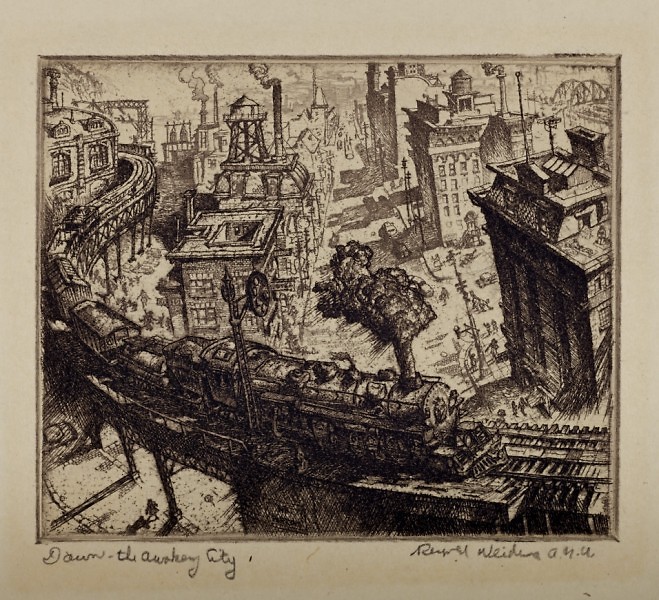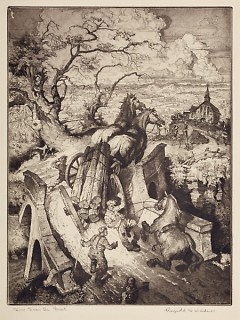For many years Reynold Weidenaar was something of a local artist hero. He was a regular downtown feature who could be seen working from his big Chevy, sketch book in hand, with a pair of binoculars and wearing his signature red beret. He has been gone 30 years now and 2015 marks a hundred years since his birth.
There are currently four different local institutions running shows of his artwork: the Grand Rapids Art Museum (GRAM), Calvin College, Kendall College of Art and Design and La Grave Avenue Christian Reformed Church. Last spring, the Grand Rapids Public Museum also had an interactive exhibit featuring his prints and a recreation of his studio. These shows all weave together to share a deep and comprehensive look at one of Grand Rapids' most important visual artists.
Weidenaar was primarily known as a printmaker, creating mind-boggling detailed prints of local Michigan scenes both from in the city and in the countryside. He was very much a part of the Regionalist art movement that came about in the 1930's along with such artists as John Stuart Curry, Grant Wood, Reginald Marsh and Thomas Hart Benton. He studied with Benton at the Kansas City School of Art. The Regionalists were known for taking the search light off from Europe for its inspiration and training its sights on what was truly American daily life. A famous example of iconic regionalist painting is "American Gothic" by Grant Wood.
Weidenaar experienced success early in his career receiving both a Guggenheim Fellowship and a Tiffany Scholarship as well as winning prizes for his prints all around the country while still in his 30s. He was celebrated in the local papers. He married Ilse Eerdmans, whose father owned the successful Eerdmans publishing company, which granted him the blessings of a supportive family and financial security.
Representational art began to fall out of favor with the rise of new art movements like abstract expressionism and later pop art through the 1950's and 60's. Weidenaar remained a harsh critic of modern art movements and at the same time began to lose some of the strong momentum he had in the early part of his career. He always continued working and went beyond printmaking to explore watercolor and oil painting.
The show at the GRAM has a good selection of his etchings as well as the drawings, watercolors and a few of the oil paintings.
Weidenaar's incredible ability to draw is the foundation of everything he produced. His tendency to create over the top dramatic compositions seem best wedded to his etching process. Pieces like "Dawn- the Awakening City" which is a print that measures only 2 1/2" x 3" is charged with dynamic energy and strong feeling. This a very romantic image of the city with a train barreling through on an elevated rail feels like equal parts Woody Guthrie and John Steinbeck.
Another etching I found particularly compelling is titled "Home from the Forest" and it depicts men leading a horses and wagon heavy loaded with logs over a bridge. This image is full of tension and trouble and the church off in the distance seems to offer little help. I cannot help but think this powerful picture of things going wrong may reflect some of the hardships Weidenaar had already experienced at an early age and perhaps hinting at more dark clouds coming in his future.
My wife Brenda Beerhorst and I had the pleasure of getting to know Weidenaar's former wife Ilse Eerdmans when we were first married. We attended the same church and Eerdmans had us over many times for lunch after church and even painted our portrait. She kind of tucked us under her wing for a little while since we were a young idealistic artist couple with our whole life ahead of us and she was the wise woman who had lived and learned so much. She even passed on some of Rey's old art materials to us that she was not using. I know their life together eventually became unraveled but for 22 years they did their best to keep a family together while still making art.
Looking through the vast collection of work in this current show at the GRAM I can't help but feel both encouraged and inspired to continue with my own creative journey as a Grand Rapids working artist.
The Rapidian, a program of the 501(c)3 nonprofit Community Media Center, relies on the community’s support to help cover the cost of training reporters and publishing content.
We need your help.
If each of our readers and content creators who values this community platform help support its creation and maintenance, The Rapidian can continue to educate and facilitate a conversation around issues for years to come.
Please support The Rapidian and make a contribution today.

